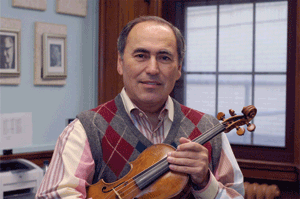

Classical Music
Shostakovich . . . Meet Weinberg . . . Weinberg, Say Hello to Eastman
 DIRECTOR: Kopelman, a professor of violin, directed the conference that explored the connections between composers Shostakovich and Weinberg.
DIRECTOR: Kopelman, a professor of violin, directed the conference that explored the connections between composers Shostakovich and Weinberg.
Sometimes even a doctorate-holding, Grammy Award–winning music professor appreciates a lesson in Russian classical music.
So says Tim Ying ’91E (DMA), an associate professor of string chamber music and a violinist for Eastman’s award-winning Ying Quartet, when it comes to Mieczyslaw Weinberg.
A close friend and one-time pupil of Dmitri Shostakovich, Weinberg was as close to unknown in American classical music as a composer can get until this fall, when the Eastman School hosted a three-day conference on the musical, artistic, and personal connections between Weinberg and his better known compatriot.
“Having done a doctorate at Eastman and thinking that I knew a thing or two about music, I had never heard of Weinberg,” says Ying, who along with musicology department chair Gretchen Wheelock, helped coordinate the gathering in September. “I learned a lot at this conference myself.”
Giving music scholars and classical music performers a chance to learn more about Shostakovich, one of the great composers of the 20th century, and introducing American audiences to the music of Weinberg was the goal of the conference, “Shostakovich + Weinberg: An Artistic Dialog.”
Directed by Mikhail Kopelman, a professor of violin, the conference marked the 100th anniversary of Shostakovich’s birth and the 10th anniversary of Weinberg’s death.
Scholars from across the United States and Russia, including Manshir Yakubov, the director of the Dmitri Shostakovich Society, presented new scholarship on the lives and work of the composers. Separately, a series of concerts featured the first U.S. performances of some of Weinberg’s music.
A former member of Russia’s famed Borodin String Quartet, Kopelman knew Weinberg when the music professor was living in the then Soviet Union. He says Weinberg is relatively unknown even in Russia, but that is changing.
Weinberg, who emigrated to the Soviet Union from Poland as a young man, was at first a pupil of Shostakovich, but he quickly outgrew that role and the two became colleagues.
“They influenced each other,” Kopelman says. “Weinberg influenced Shostakovich and Shostakovich influenced Weinberg. But Weinberg has his own musical language.”
Although separated by about 15 years, the careers of the two ran along similar tracks. Both took to writing film scores, for example, when they fell out of favor with Communist officials.
Both drew on similar inspirations and tried to capture similar ideas in their music, Kopelman says.
“For Shostakovich and for Weinberg, it was hard to live during the Communist era,” Kopelman says. “All the pain they felt, all the suffering of the people—they put that in their music. They wrote their music with blood.”
While there’s little chance that Weinberg’s music will reach the stature of Shostakovich’s—“There’s no question Shostakovich is one of the greats of the 20th century,” Ying says—the conference offered a chance to think about music and performance in new ways.
That focus on combining new scholarship with performance is unusual for a music school but is the hallmark of Eastman, Ying says.
“As a music school, Eastman tries to balance performance with scholarship,” Ying says. “We’re in a special position in trying to bring both sides together.”
—Scott Hauser
